
Steamboat Ephemera - Cartoons
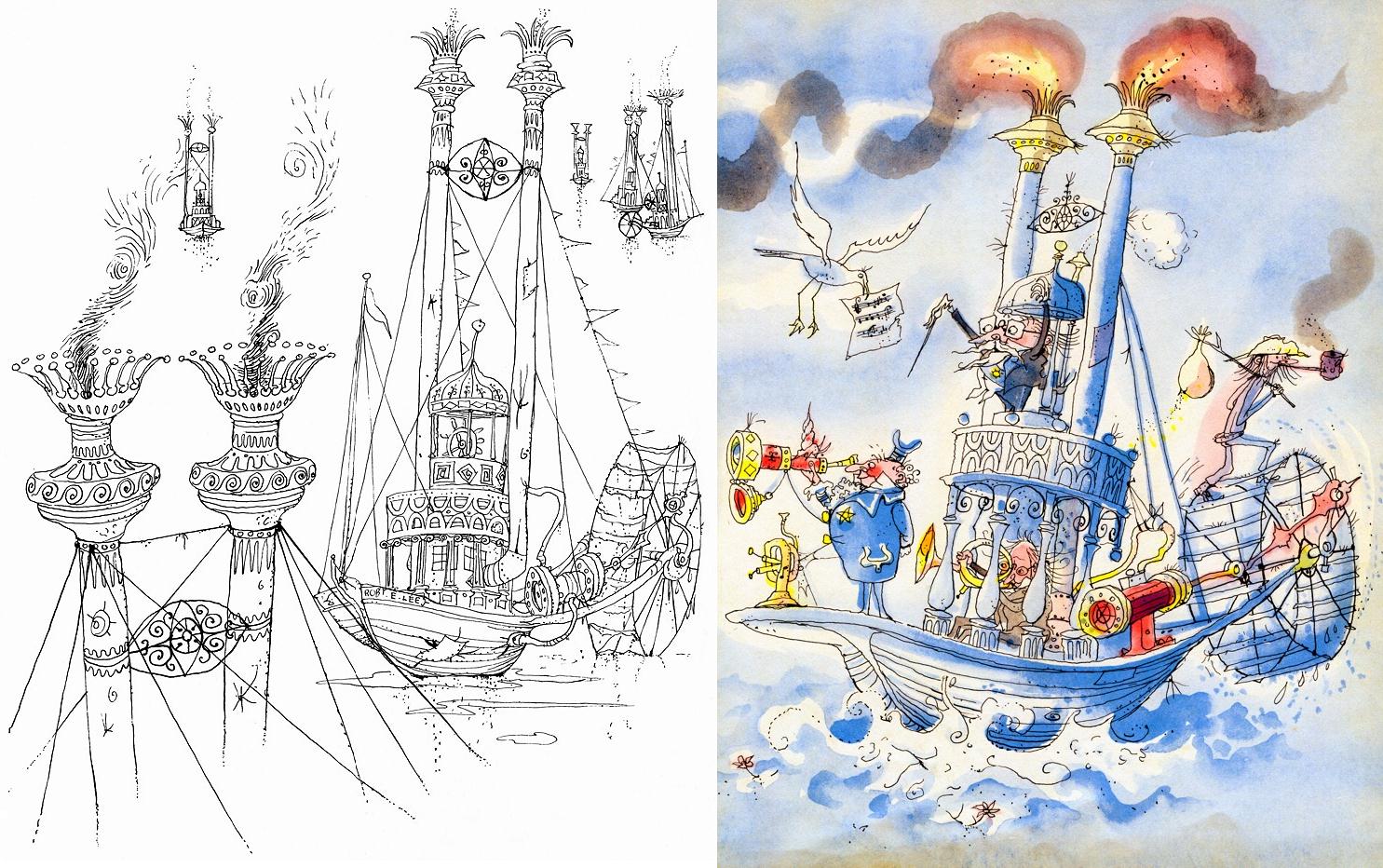
I recently discovered the artwork of British cartoonist Rowland Emett who drew for the UK magazine PUNCH.
Emett specialized in wild and wonderful cartoons inspired by locomotives and passenger cars of the British railways.
In 1952 Rowland transported his cartoon locomotive NELLIE to the U.S.A. in the book NEW WORLD FOR NELLIE.
NELLIE traverses America and while in the Deep South discovers our steamboats.
NELLIE's engineers "immediately fell in love with the paddle boats because they had TWO long funnels each." (Referring to the smokestacks).
Attached is one of the 4 steamboat pen and ink drawings from pages inside the book and a color illustration featured in the fly leaves at each end of the book.
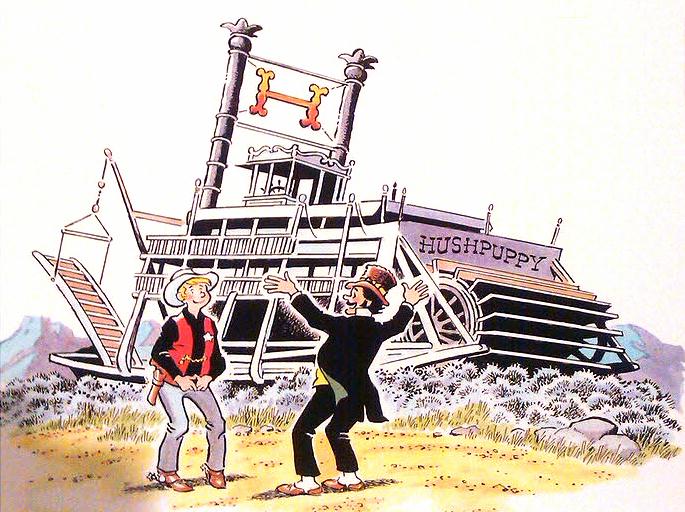
Stan Lynde, the creator of one of my favorite comic strips passed away last week. Attached detail is from the cover of a collection of Rick O'Shay dailies from 1963-64. The beautifully drawn steamboat HUSHPUPPY is mysteriously grounded in a clump of sagebrush Out West. Obituary below is abridged from Stan's obituary from the L.A. Times:
Times Staff and Wire Reports
August 12, 2013, 8:34 p.m.
Stan Lynde who created the syndicated Western strip "Rick O'Shay," which ran for 20 years in major newspapers and reached about 15 million readers, died Tuesday August 6th, 2013 in Helena, Montana He was 81.
Inspired by the cowboys of his youth, Lynde developed his "Rick O'Shay" comic strip, which was first syndicated in 1958. The characters in the comic strip were composites "of the old-time cowboys and the people I knew growing up," Lynde once said.
He grew up on a cattle and sheep ranch near Lodge Grass, Mont., on the Crow Indian Reservation. Lynde populated his imaginary western town with such figures as lawman Rick O'Shay, gunslinger Hipshot Percussion and a kid named Quyat Burp.
In 1962, Lynde returned to Montana after "Rick O'Shay" was established and appearing in about 100 papers, including The Times. He set up a basement in his Billings home and bought a 160-acre ranch, branding his cattle with "RIK" in honor of his cartoon hero.
He was born Myron Stanford Lynde on Sept. 23, 1931, in Billings and grew up listening to his parents read him the Sunday comics. He later recalled wanting to be a cartoonist since age 5 or 6.
"I've been able to do the work I love for an appreciative audience," Lynde said in December. "I love this state. ... If my tombstone said something about Montana, I'd be really happy. I've never met any state with people who have such character."
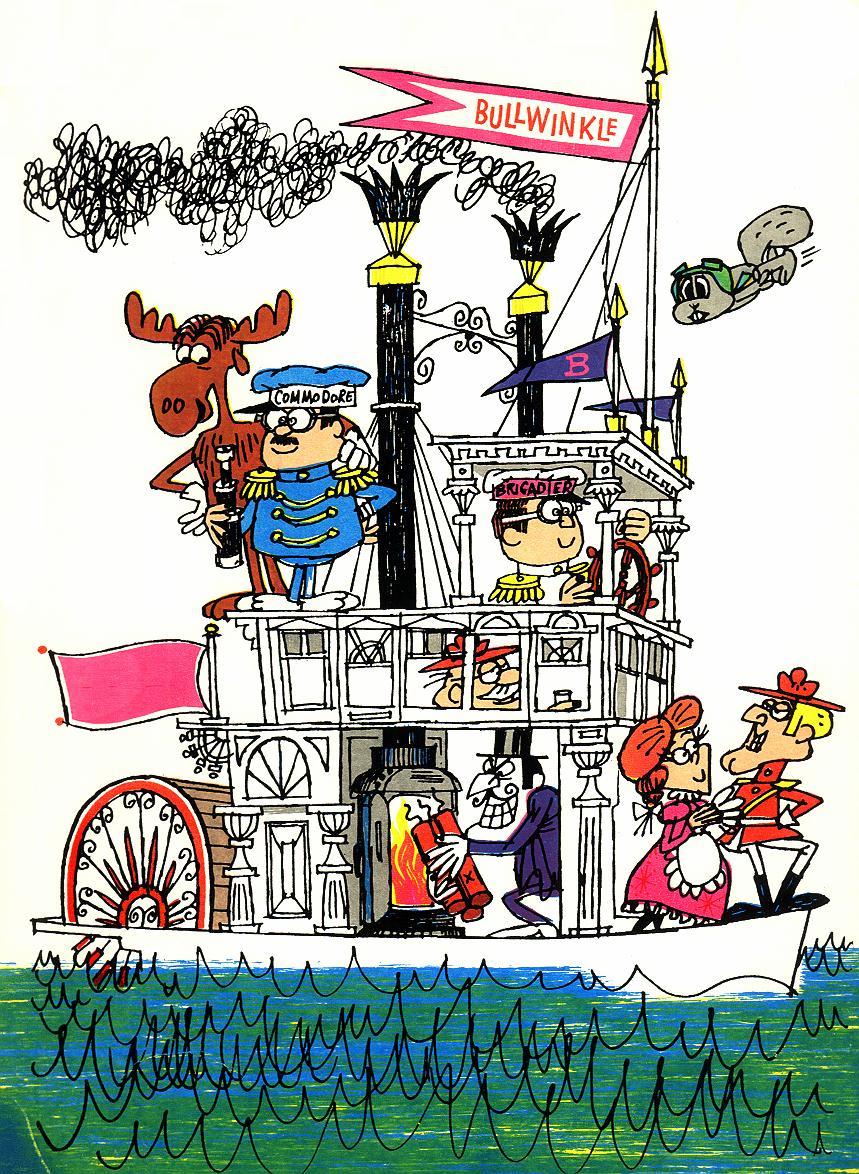
Attached is a scan of a printed ink and color drawing of a fanciful steamboat for Rocky and his Friends aka The Bullwinkle show produced by Commodore Jay Ward and piloted by Director Brigadier Bill Scott (I'm pretty sure who that's supposed to be) with Bullwinkle Moose, Rocky the Flying Squirrel up top also. On deck Inspector Fenwick drinking on Texas deck. Below him is his daughter admiring Dudley Do-Right of the Mounties while Snidely Whiplash prepares to blow up the boat. I have this one matted and framed, around 11x14 size. Boat resembles a Rose Parade float, this could 'a been concept art work for such a thing. Who knows? Perhaps the print was enclosed with Christmas cards from Jay Ward's Studio back in the 60's. - Dave
Editor's note (01-30-2024) "And now, here's something we hope you'll really like!" Steamboats.com received a story about this artwork from Scott Keselowski:
I was glad to see you also had a copy of the Rocky and Bullwinkle art. The only other one I have seen online! Ours was gifted in 1967 to my wife's father. He was a teacher of one of the studio workers' children. I believe one of the main people from that production company. The name on the boat - S.S. Stephen Haims - is my wife's father and was hand done by one of the artists from there for sure, it looks perfect. Also in 1967 nobody but basically that studio could make such wonderful prints!
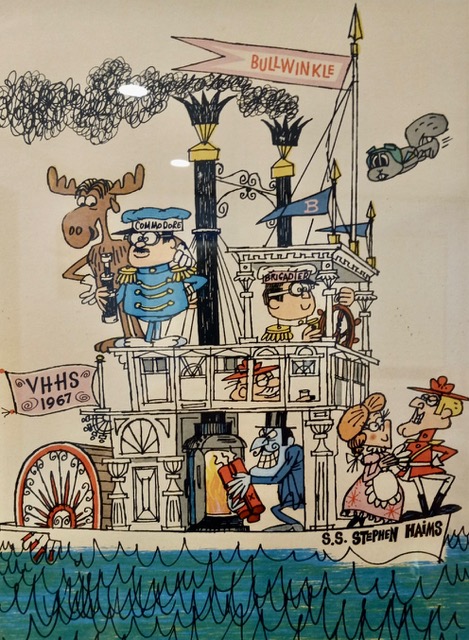
Thanks Scott for sharing your family's customized version of this image. What a great story!
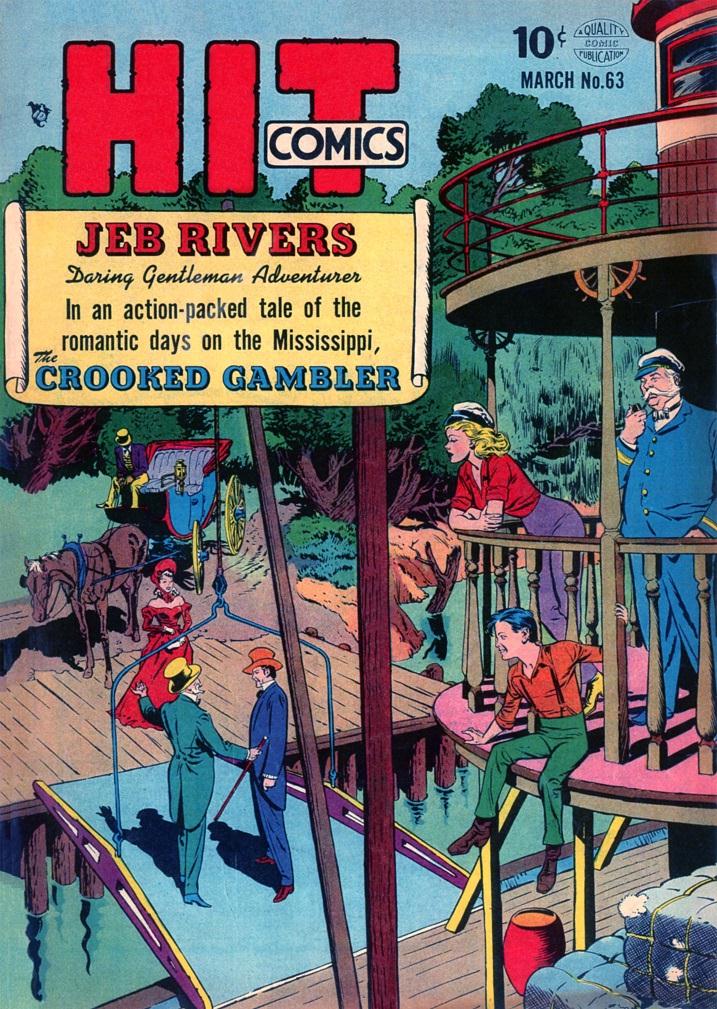
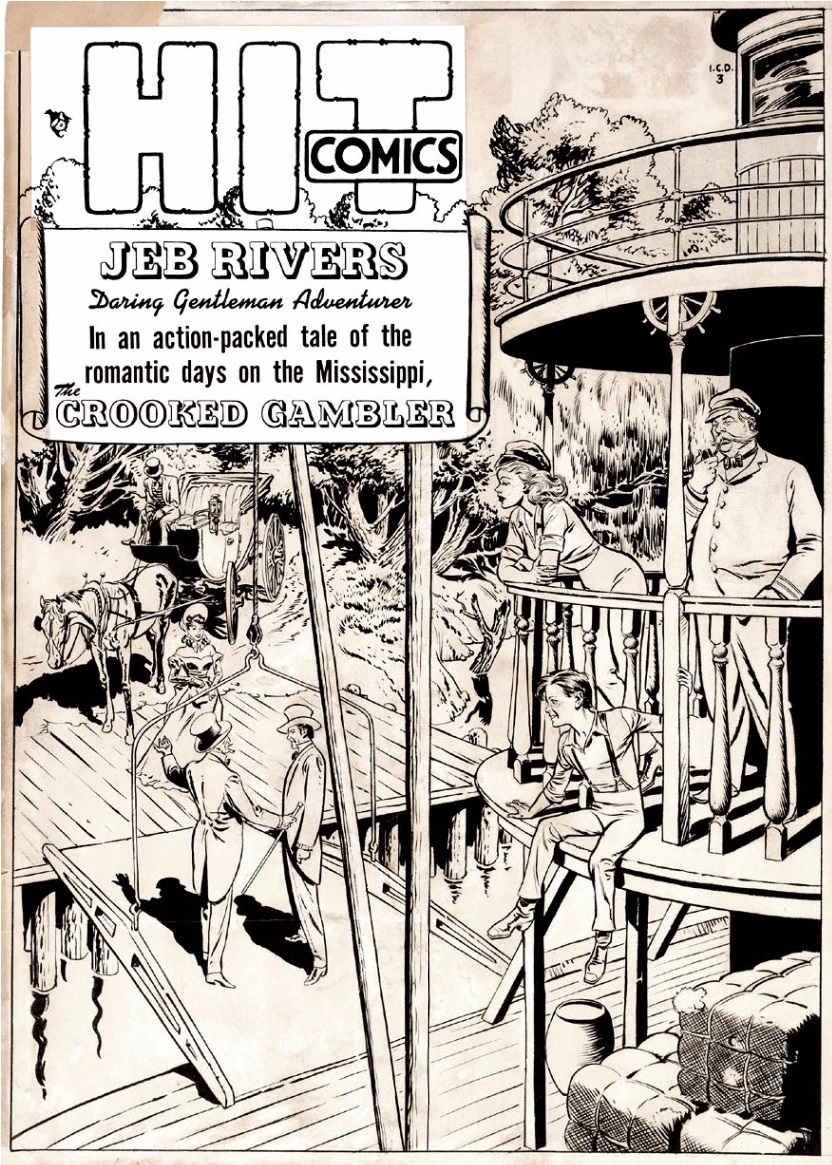
Comic Book 1950 "Jeb Rivers: The Crooked Gambler"
Cover of 1950's comic book: Jeb Rivers: "The Crooked Gambler"
Hit Comics Vol 1 #63
March, 1950
Published by Quality Comics
Cover Artist Reed Crandall
The original black and white pen and ink drawing (see attached) for this cover is for sale by ROMITAMAN: romitaman.com
Hit Comics #63 Cover (Large Art) drawn in 1949
GOLDEN AGE cover, which was penciled and inked by Reed Crandall, from the story titled: "The Crooked Gambler."
This cover features Jeb Rivers, the Daring gentleman adventurer, awaiting a beautiful damsel walking up to board the riverboat, with finely dressed men, lovely women, and even a Tom Sawyer-ish boy.
Jeb Rivers, Daring Gentleman Adventurer, was the cover feature of the last few issues of this HIT COMICS series, in the days after superheroes had fallen out of favor. A huge image crafted in ink over graphite on illustration board with an image area of 13.25" x 18.75". The logo and cover text is a recent replacement stat.
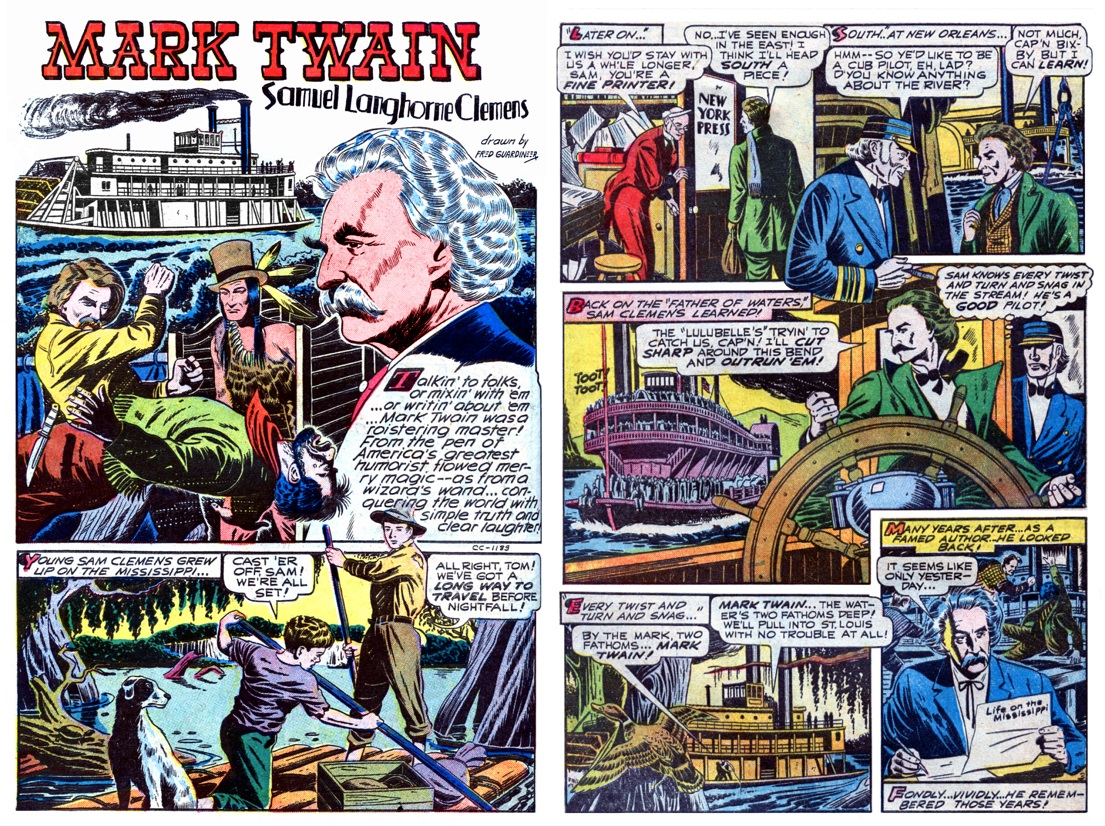
Comic book IT REALLY HAPPENED pages devoted to MARK TWAIN drawn by artist Frederick B. Guardineer
Attached composite of the first and third pages from the mini-biography of Mark Twain (Sam Clemens) excepted out of the biographical comic book series "It Really Happened"
IT REALLY HAPPENED
"Picture stories of Popular Heroes" #10 of 11 in the series of biographies
Published in 1947 by Pines Publishing
In this issue: Mark Twain, Sir Richard Francis Burton, "Honus" Wagner among others
Attached composite scan of Pages 1 & 3 for the story of MARK TWAIN Samuel L. Clemens drawn by Fred Guardineer
Wikipedia
Frederick B. Guardineer (October 3, 1913 - September 13, 2002) was an American illustrator and comic book writer-artist best known for his work in the 1930s and 1940s during what historians and fans call the Golden Age of Comic Books, and for his 1950s art on the Western comic-book series The Durango Kid.
A pioneer of the medium itself, Guardineer contributed two features to the seminal Action Comics #1, the comic book that introduced Superman.
Fred Guardineer was born in Albany, New York. He acquired a fine arts degree in 1935, then moved to New York City, where he drew for pulp magazines.
The following year he joined the studio of the quirkily named Harry "A" Chesler, an early "packager" supplying comics features on demand for publishers entering the emerging medium of comic books.
There he drew adventure features such as "Dave Dean" and the science-fiction feature "Dan Hastings" before going freelance in 1938.
Guardineer's first known comics credits appear in several one to three page Western and comic-Western stories, and in spot illustrations for a text story, in Centaur Publications' Star Ranger #2 (cover-dated April 1937).
Through that year, he continued writing and drawing such short features in a variety of genres in some of the medium's first comics, including Centaur's Star Comics, '"Funny Pages and Funny Picture Stories.
He is among the contributors to the future DC Comics' landmark title Action Comics #1 (June 1938), the landmark comic that introduced Jerry Siegel and Joe Shuster's seminal superhero Superman.
There Guardineer wrote, drew and lettered the 12-page feature introducing his magician-hero creation Zatara, a character remaining in the DC stable as of the 21st century.
Guardineer was also one of the artists on two features handled previously by Creig Flessel in More Fun Comics: "Pep Morgan" (on which he sometimes used the pseudonym Gene Baxter) and, in Detective Comics, "Speed Saunders, Ace Investigator".
He married Ruth Ball in 1938 and bought a home in Long Island, New York the following year.
Guardineer's other early work includes art for Quality Comics, where he created the character Blue Tracer; and Columbia Comics, where he worked with former DC editor Vin Sullivan, who had edited Action Comics.
Guardineer followed Sullivan to the editor's next venture, the comic-book company Magazine Enterprises, which Sullivan founded. There from 1949-1955, Guardineer drew writer Gardner Fox's Old West masked-crimefighter series The Durango Kid. In the late 1940s, he also drew for such Lev Gleason Publications comics as Black Diamond Western and Crime Does Not Pay.
In 1955, Guardineer retired from comics and worked 20 years with the U.S. Postal Service, and during this time did wildlife illustrations for publications including The Long Island Fisherman. He was a member of the Outdoor Writers Association of America.
Popular-culture historian Ron Goulart called Guardineer ". . . a true nonpareil, an artist whose style was unmistakably his own. . . . His style was almost fully formed from the start. He seems always to have thought in terms of the entire page, never the individual panel.
Each of his pages is a thoughtfully designed whole, giving the impression sometimes that Guardineer is arranging a series of similar snapshots into an attractive overall pattern, a personal design that will both tell the story clearly and be pleasing to the eye . . ."
Comics historian Mark Evanier wrote that during Guardineer's years away from comics, Mad magazine writer and editor Jerry DeFuccio located him "and became the first of many collectors to pay what Guardineer considered tidy sums to re-create some of his old covers." Guardineer again lost contact with the comics community until 1998, when a comics fan found him in northern California and convinced him to attend that year's Comic-Con International in San Diego, California. There, he was part of an Evanier-hosted panel "of every surviving person who'd had a hand in the creation of the historic Action Comics #1.
When presented with the convention's Inkpot Award, Fred was confined to a wheelchair but with great effort, he insisted on standing as he made a brief but eloquent acceptance speech."
Guardineer later was a guest at WonderCon, in Oakland, California.
One source says Guardineer moved to San Ramon, California, where he died in 2002, though the Social Security Death Index gives his last place of residence as Babylon, New York (ZIP Code 11702) in Suffolk County, Long Island.
It Really Happened: MARK TWAIN (1947)
Tuesday, March 3, 2020
davycrockettsalmanack.blogspot.com
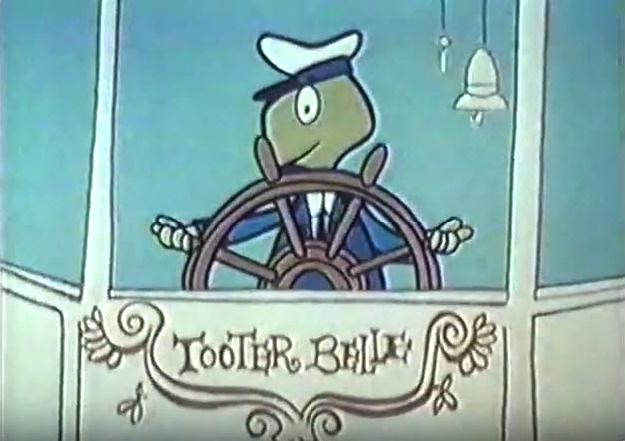
Tooter Turtle #15 Steamboat Stupe (Captains Outrageous)
"Educational" cartoon short subject #15 in the "Tooter Turtle" series. looks like and sounds like something from Jay Ward's Bullwinkle Moose and Rocket J. Squirrel crew. Kind of a "Young Person's Guide to Bein' a Steamboat Cap'n" . . .
Tooter Turtle #15 Steamboat Stupe (Captains Outrageous)0SH Youtube siresounds Published on Sep 23, 2016 Episode #15 of 39 produced in 1960-61.
Home recorded on VHS (South Florida) in the mid 1990's: a segment on Tennessee Tuxedo and his Tales, which aired at 6 AM on channel 39.
Wipipedia summation of the series:
Tooter Turtle (sometimes spelled Tudor or Tutor) is a cartoon about a turtle that first appeared on TV in 1960, as a segment, along with The Hunter a detective dog, as part of the King Leonardo and His Short Subjects program. "Tooter Turtle" debuted on NBC, on Saturday, October 15, 1960, and ran for 39 original episodes through July 22, 1961. These episodes were later rerun as backups on other cartoon shows, but no more original episodes were made.The plots followed the same general format. Tooter (voiced by Allen Swift) calls on his friend Mr. Wizard the Lizard (voiced by Sandy Becker), an anthropomorphic lizard wearing a wizard cone hat, a robe, and pince-nez eyeglasses. Mr. Wizard lived in a tiny cardboard box at the base of a tall tree. The introductory segment had Tooter knocking on the cardboard box, having "another favor to ask." From inside the box, Mr. Wizard would shrink Tooter small enough to enter through the box's front door and invite him in. Mr. Wizard has the magic to change Tooter's life to some other destiny, usually sending him back in time and to various locales.
As Tooter is doing his destiny, Mr. Wizard narrates about it. When Tooter's trip finally became a catastrophe, Tooter would request help with a cry of "Help me, Mr. Wizard, I don't want to be X any more!" where X was whatever destiny Tooter had entered. Mr. Wizard would then rescue Tooter with the incantation, "Drizzle, Drazzle, Drozzle, Drome; time for this one to come home." Then, Mr. Wizard would always give Tooter the same advice: "Be just what you is, not what you is not. Folks what do this has the happiest lot."
Mr. Wizard's phrase "Drizzle, Drazzle, Druzzle, Drome; Time for this one to come home" is echoed in the phrase "Razzle, dazzle, drazzle, drone, Time for This One to Come Home" that was used later by the band The Replacements as a lyric in Hold My Life from the album Tim.
Created and airing during the Vietnam War, although before the Gulf of Tonkin Incident, the episode featuring Tooter traveling back to WW I as a fighter pilot ("Tailspin Tooter") features what one historian has called some of "the most gruesome pro-war imagery" in cartoons of the period.
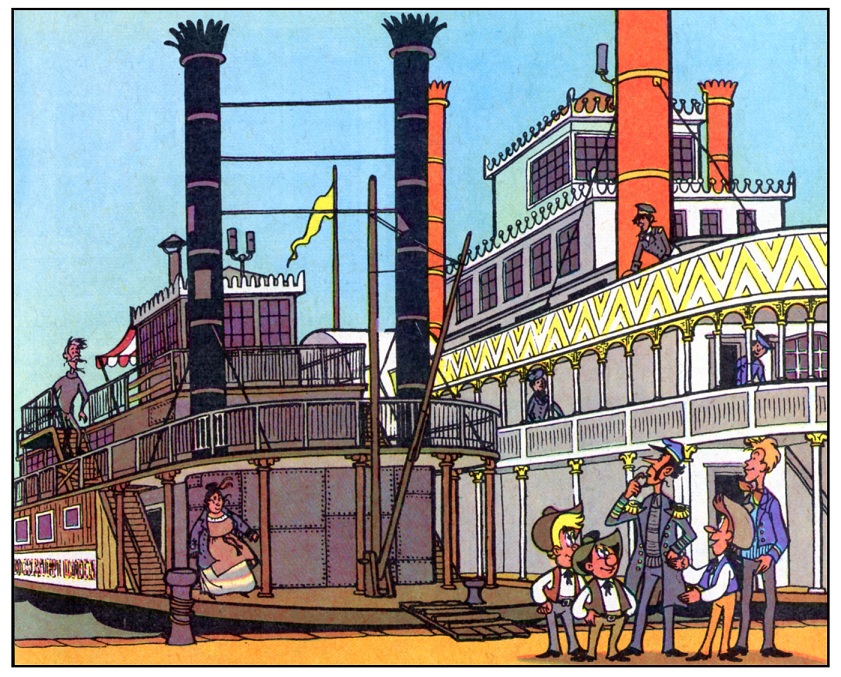
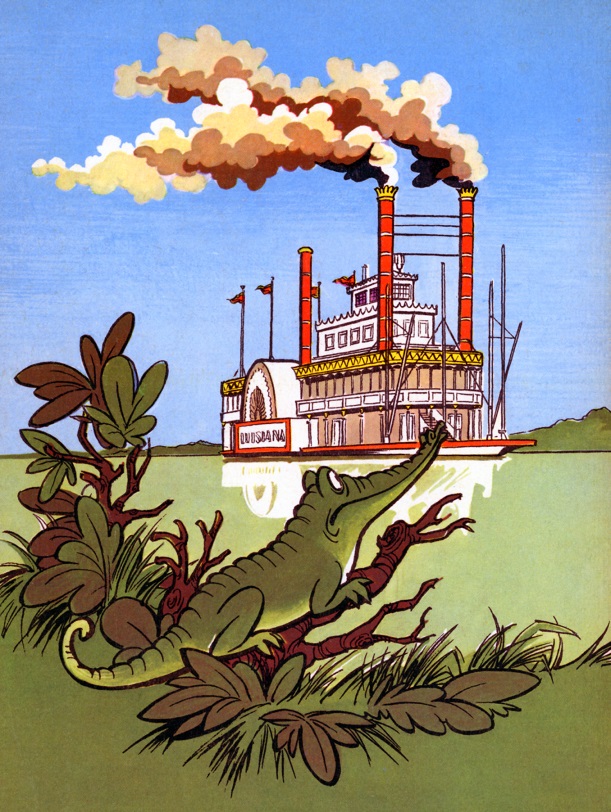
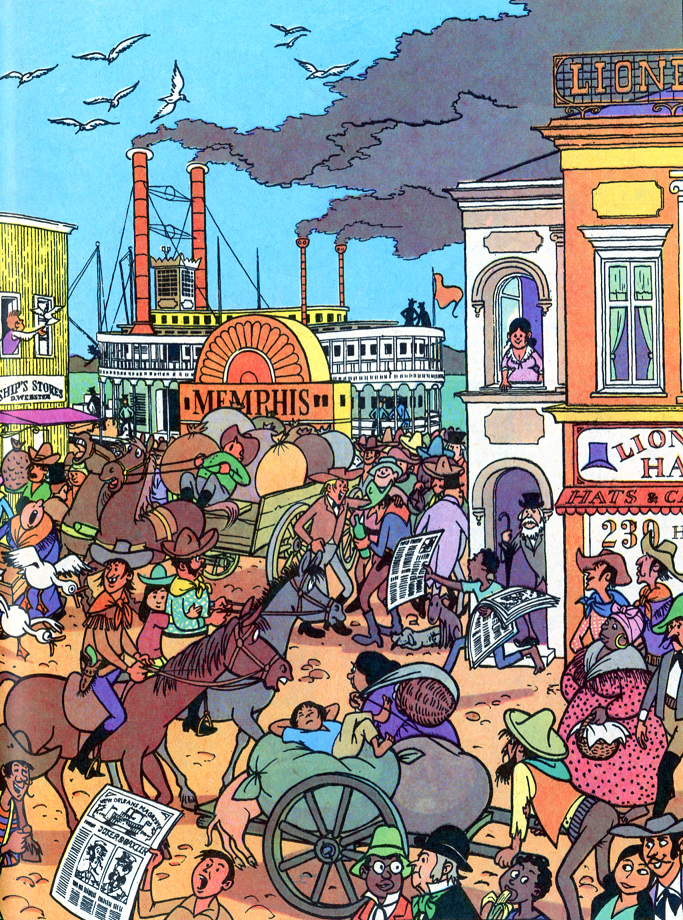
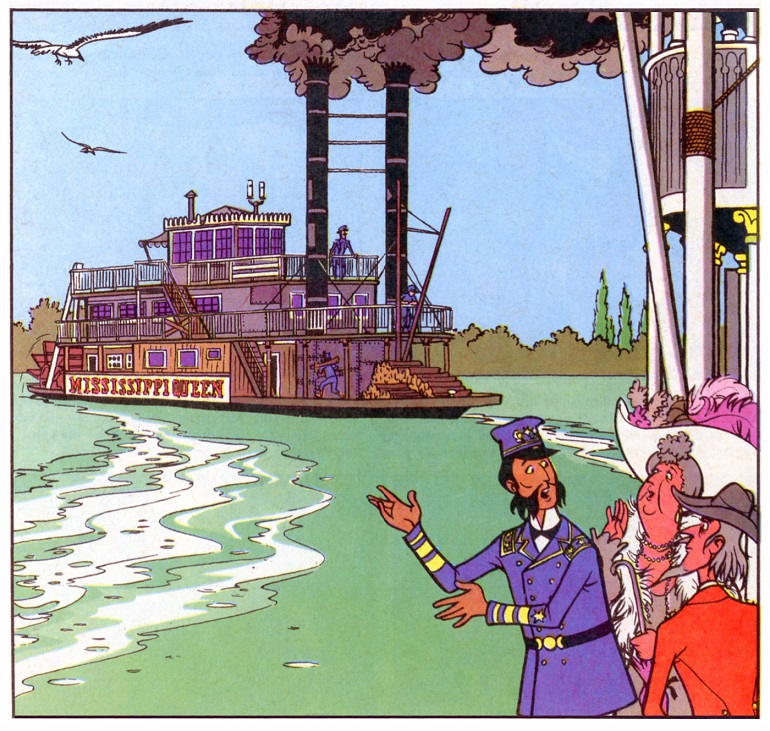
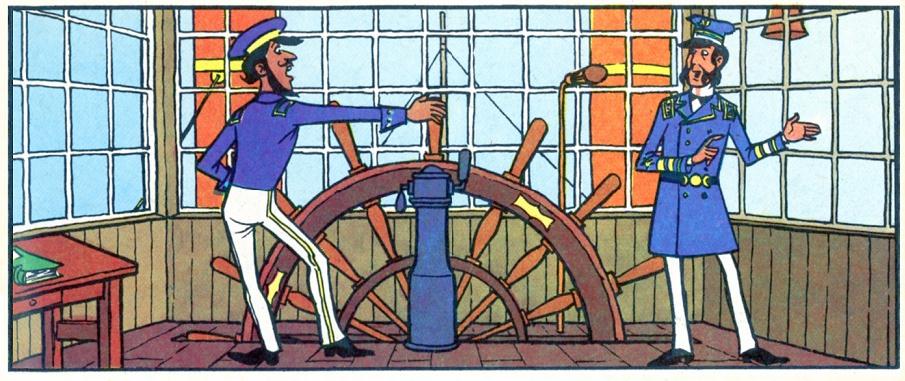

Mosaik/Amerika steamboat graphics
Attached are 8 panels from Mosaik/Amerika German comics from the '50's. My friend Andreas in Berlin kindly sent me 3 of the out of print Mosaik books and I scanned and enhanced the color on just some of the steamboat inked and painted graphics. There are a great number of them in the 3 books:
The Digedags in America
The Digedags on the Mississippi
The Digedags in New Orleans
Europeans are fascinated with our historic boats and the creators of comics frequently use them in stories of Western heroes whose frontier begins on the banks of the Mississippi River where they're frequently involved in colorful action stories of gambling and boat races.
Wikipedia - Mosaik
Wikipedia - Hannes hegen
Mosaik is a German comic book magazine. First published in December 1955, it is the longest-running German (and European) monthly comic book and the only one originating in East Germany that still exists. Mosaik also appeared in other countries and other languages. In its English-language edition it was published under the title Mosaic.
Mosaik was created by illustrator and caricaturist Hannes Hegen. (real name Johannes Eduard Hegenbarth; 16 May 1925 - 8 November 2014) From 1955 to 1975, the protagonists of Mosaik were Dig, Dag and Digedag, known together as the Digedags.
They were replaced in 1976 by Abrax, Brabax and Califax, known together as the Abrafaxe, who are still the main characters today.
More than 200 million issues have been sold from 1955 until today. At the height of its popularity, prior to German reunification, Mosaik had a print run of almost a million copies per month. After reunification, the print run has varied from more than 100,000 in the early 1990s to about 80,000 in 2007.
Digedags years:
The East German publisher Verlag Neues Leben, in East Berlin, had wanted to counter Western comics and magazines with a magazine of their own when Hannes Hegen approached them with his ideas for Mosaik and the Digedags. Reaching an agreement with Neues Leben, Hegen created the first issue of Mosaik for publishing in December 1955. Mosaik was published quarterly until July 1957, when it switched to a monthly schedule that has continued uninterrupted to this day. To support the schedule, the publisher hired additional artists, colorists and writers to support Hegen - a team which became known as the Mosaik-Kollektiv (Mosaik Collective). Only Hegen was credited on the cover, however.
In 2008 Hannes Hegen received the Max & Moritz Prize, the most important German prize for comic artists from the International Comic Salon Erlangen. In 2010 he was awarded for his creative work, the Order of Merit of the Federal Republic of Germany (Knight's Cross, or Merit Cross on Ribbon, German: Verdienstkreuz am Bande).
The Digedags in America 1
The Digedags on the Mississippi 2
The Digedags in New Orleans 5
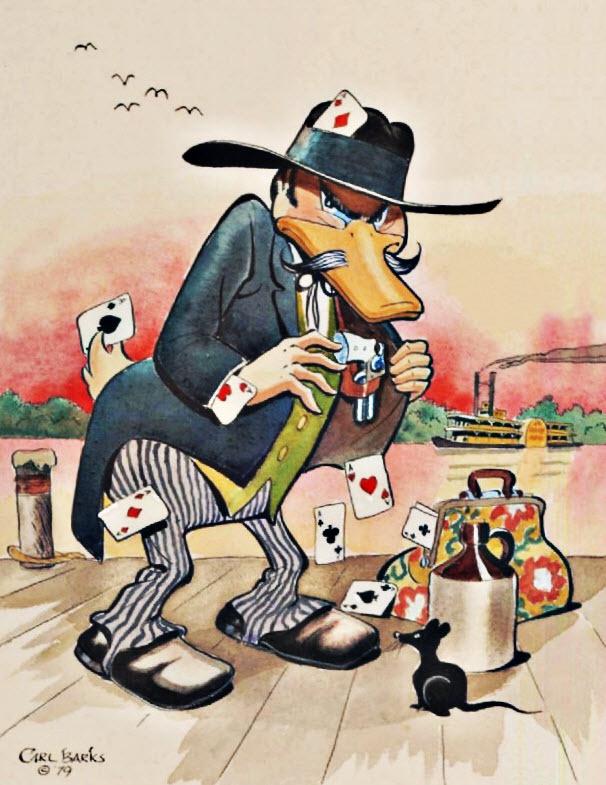
Carl Barks artwork of a Disney-style cartoon Riverboat Gambler "Duck" 1979
Here is a wonderful 1979 Carl Barks pen & ink with watercolor painting on illustration board of a melodramatic mustachioed Riverboat Gambler Duck "villain," who is just bristling with Aces while he reaches for his derringer on a Mississippi River dock next to his carpetbag and jug of "corn likker" as an inquisitive little black mouse looks him over while in the distance a sidewheel steamboat paddles along.
Wikipedia
Carl Barks (March 27, 1901 - August 25, 2000) was an American cartoonist, author, and painter. He is best known for his work in Disney comic books, as the writer and artist of the first Donald Duck stories and as the creator of Scrooge McDuck. He worked anonymously until late in his career; fans dubbed him "The Duck Man" and "The Good Duck Artist." In 1987, Barks was one of the three inaugural inductees of the Will Eisner Comic Book Hall of Fame.

Yarns by the Yard - By R. V. Garber No. 1 Famous Whistle Creek Steamboats
Yarns by the Yard
By R. V. Garber
No. 1": Famous Whistle Creek Steamboats
NATIONAL WATERWAYS
FEBRUARY 1932
pages 26 & 48
Time has blotted out old landmarks which might lead to the recalling of the one-time famous Whistle Creek and its steamboats, obliterated in 1811 by the New Madrid Earthquake which completely buried creek and boats for all time. Some of the old faithful descendants of rivermen still believe, as did their forefathers, that Whistle Creek and its steamboats is still in existence, now flowing under the ground as placidly as ever on its way to the Mississippi.
But Whistle Creek is only a memory. But what a memory! In 1800 steamboating on Whistle Creek was at its heighth and glory. The famous Tri-State Packet Line, owned by Captain Trio, was operating three steamers: the State of Collapse, State of De Jection, and the State of De Pendence. These boats are deserving of mention
The State of Collapse was built at New Orleans in 1790, out of the lumber from a dismantled whaling ship. She was the largest of the three boats, being 125 feet long and 32 feet wide. Because she was so long she could not be turned around in the Creek at any point, so a pilot house was built at both ends of her with a smoke stack behind each. Thus, when she reached the end of her run the pilots, like a motorman on a one-man street car, simply changed pilot houses and ran the boat backwards.
The State of De Jection was formerly owned by Captain Mellon Cholly of Vicksburg, Miss., who became so depressed after riding on her for one season that he committed suicide by jumping into her sternwheel. The De Jection was said to be the slowest steamboat ever built. It was known to be a fact that if sails were installed on her she would make better time in the calmest weather with her engines stopped, than she would with them going full speed ahead. It was Captain Mellon Cholly himself who gave the poet Samuel Taylor Coleridge the inspiration for his poem, "Dejection: An Ode."
The State of De Pendence was built out of the old State of Coma which exploded in 1795, leaving her master, Captain De Linquent, in a profound condition of insensibility. He set to work to rebuild her, but when he got her finished he had used up all his fortune, so she was sold to the Tri-State Line who named her State of De Pendence because her usefulness after her explosion was always depending upon additional money for new parts. She was, however, unusually fast, which was believed the cause of her explosion. Often times if her engines were allowed to run full speed her wheels would revolve so fast they would suck all the water away from around her hull, and she would be seen scraping along the river bottom going from thirty to thirty-five miles an hour with mud flying in all directions.
The State of De Jection was in the peanut butter trade between Cairo, Ill., on the Mississippi and Poplar Bluff, Mo., on Whistle Creek. Because she was so slow the peanut butter concern moved their factory on the boat, and so peanuts loaded at Cairo were made into peanut butter, put into jars, and were ready for distribution by the time the De Jection reached port. The State of De Pendence was in the apple butter trade between Hamburg, Ill., on the Mississippi, and Poplar Bluff on Whistle Creek, a distance of 860 miles which this boat covered in a day and a half. She was so fast she would often be back at Hamburg before the apple pickers had gathered enough of the fruit to make another trip profitable. The State of Collapse ran in the cotton trade between Memphis, Tenn., on the Mississippi and Poplar Bluff on the Creek.
One night these three boats met in a triple collision at Dead Man's Elbow on Whistle Creek. The damage would have been slight had it not been for the terrific speed at which the De Pendence was traveling. As it happened, the State of Collapse was passing the State of De Jection just as the State of De Pendence whizzed around the Elbow unaware of the presence of her sister boats. She ran between the left bank and the State of De Jection, side-swiping her and pushing her against the port side of the State of Collapse which forced both these boats out of the creek and up on the right bank with peanut butter and cotton flying hither and yon. It was a terrible sight to see the stricken passengers and crew struggling through this sticky conglomeration which held them like flies in molasses. The peanut butter was worse than quicksand, while the cotton suffocated scores. Many believe that this mixture of peanut butter and cotton lead to the making of what is known today as "Karmel Carn."
The accident happened so quickly that the State of De Pendence reached port before she could stop or was aware of what had taken place. And that was the end of the State of Collapse. She was true to her name after that—a mass of wreckage high and dry on the bank where she remained until the earthquake buried her. The State of De Jection, however, was reconditioned, but she turned out to be slower than ever and never reached Cairo again because, on her first trip out her crew died of old age on the way.
The State of De Pendence remained in service and was not destroyed until the day of the New Madrid Earthquake when, in an effort to out-distance the earth tremors, she ran into some low-hanging trees and tore off her upper works while the hull, with the engines on it, ran wild across country for an hour and a quarter until her fuel supply gave out. She then make a perfect landing with her port side against a farm house which a second later was wrecked by the quake and collapsed just as the farmer and his family ran out to seek shelter in the hull.
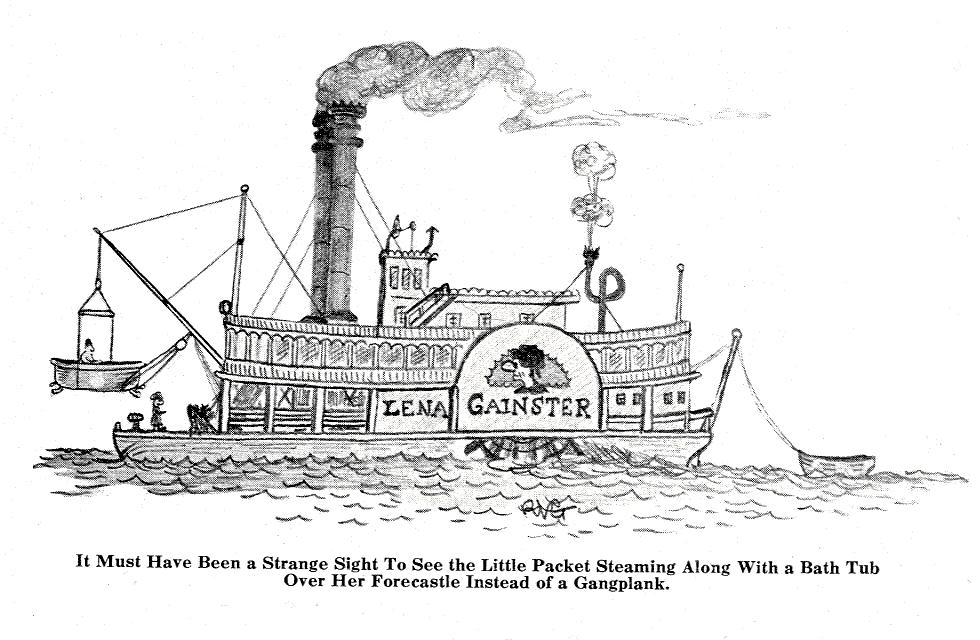
"DEEP FOUR" No. 3 by R.V. Garber
Another curiosity from R.V. Gerber in prose along with a cartoon he drew of the steamboat LENA GAINSTER.
NATIONAL WATERWAYS
APRIL, 1932
YARNS BY THE YARD by R.V. Garber
"DEEP FOUR" No. 3
Mrs. Captain Lena Gainster nonchalantly spat tobacco juice over the rail of the hurricane deck aboard the steamboat which bore her name, and with a ring of agony in her deep, gruff voice, spoke to the figure-head beside her, a small, thin, timid gentleman who was none other than her husband. "If this Depression keeps on," she grumbled, "I'm going to junk this mud scow and clear out!"
That was many, many years ago, down on the verdant banks of the Suwannee River, so the story goes, and where it seems, there was a business depression that was so bad it makes our present hard times seem like a boom. The packet boat business on Suwannee River at that period had been hit so terrible that most of the steamboat owners were forced to dispose of all their land property and live on their boats. The first winter was so hard that these very men and their families could not afford to buy coal, and thus, while they lived in one part of their steamboat, they gradually dismantled other parts, using the wood for kindling, so that by the time summer arrived all that was left of the boat was the pilot house stove which had consumed the rest of the craft during the cold weather.
Mrs. Captain Lena Gainster's staunch namesake was one of the few packet boats left on that river in the spring of 1832, and with her husband as chief engineer, she was trying her best to eke out a living in the clothes prop trade which had once been flourishing. But now people were not washing their clothes, since their clothes were worn out and they had no money to buy new ones. No wonder, then, that Mrs. Captain Lena Gainster was worried as well as angry as she paced up and down the hurricane deck, while her husband, unaffected by Depressions or anything else, fell asleep and snored contentedly in the warm summer sun.
One day, to add insult to injury, one of the greatest floods in the history of the Suwannee River destroyed everything that the Depression had not already ruined, and while on her last trip in the clothes prop trade, a most extraordinary thing happened to Mrs. Captain Lena Gainster and her husband, which gentleman was, at the time, on one of his many vacations. It seems that the speedy little side wheel packet was coming up stream battling the flooded waters with Mrs. Captain Lena Gainster at the wheel, when the woman-Captain suddenly spied her house floating down the river, and heard her husband's voice inside calling for help. "Why doesn't the idiot get out on the roof?" she thought as she pulled up along side the floating house and sent some roustabouts in through a second story window after her husband. The roustabouts reported that the reason the gentleman was not on the roof was because he had been taking a bath when the river suddenly carried the house away and left him helplessly stranded in the tub with all clothing and other means of covering gone.
There was only one way to save her husband. He must be extracted from the house, tub and all. Quickly Mrs. Captain Lena Gainster ordered the stage lowered onto the forecastle of the packet and uncoupled from the boom. Meanwhile other roustabouts were chopping a large hole in the roof of the house with fire axes. The boom and rigging were then hoisted over and the rigging lowered through the hole in the roof, where it was made fast to the bath tub inside the house. A few seconds later the derrick hoisted bath tub and chief engineer out of the rapidly sinking dwelling, and it must have been a strange sight to see the little packet steaming along with a bath tub hanging over her forecastle instead of a gangplank.
Upon the loss of her property Mrs. Captain Lena Gainster found herself bankrupt. Her patience exhausted, and in a fit of anger, the woman navigator suddenly decided to turn river bandit. As the story goes, she ran her packet up to the headwaters of the Suwannee River in the Okeefenokee Swamp in Georgia, tied it up, and left her husband to watch it until she returned.
"When I come back," she told him gruffly, "I'll have more treasures than Captain Kidd ever saw in his time. And another thing!" she added, shaking her large finger in the little man's sleepy face, "don't let any one come aboard this packet, because I intend to conceal all the treasure I get in the hull until I'm ready to steam this mud scow back to town with it."
And thus the little packet LENA GAINSTER came to be known as the "Ghost Ship." For years she creaked and groaned at her moorings in the dismal swamp. Curious townspeople who ventured within sight of her, looked at her with fear in their hearts, and if the slightest breeze caused even so much as a shutter to slam on the boat and break the solitude of the lonely swamp, these persons would take to their heels like frightened rabbits. Some of the more daring, however, came back with stories that, if at night you got close enough to the packet you could her her 'scape pipes breathing softly in the night air as if the boat was impatiently waiting for its lady-Captain to return and run it back to town with its vast treasure. Finally, an exceptionally brave chap who went aboard the boat late one night, explained that the breathing of the 'scape pipes had been mistaken for the irregular breathing of Mrs. Captain Lena Gainster's husband who had developed asthma. This chap told also that the engines of the little packet were freshly oiled and in readiness to transport the large treasure chests which the lady-Captain and bandit was housing in the spidery, bat-infested hull of the steamboat.
After she had left her husband to watch the little packet in the swamp, Mrs. Captain Lena Gainster, the lady bandit, stole a motor boat and barge and proceeded down the river. At night she would pull up beside a landed steamboat whose crew were asleep, and dismantle as much of the boat as was possible, loading the material on the barge. In this manner she finally got together enough material off of different boats to build her own packet, and this she did, naming the boat MISS FORTUNE after the Depression which was still on.
She then proceeded to tour up and down the Suwannee River in the MISS FORTUNE, robbing and plundering other boats and people, and hiding the loot in the hull of the LENA GAINSTER. Her method of plundering was most unusual. She would anchor the MISS FORTUNE in a shadowy cove of the river and wait for an approaching steamboat. As it neared the cove the woman bandit would lasso the unsuspected packet and pull the boat into the cove with the capstan of her own steamer before the surprised officers on watch could cut or break their boat loose from the line. Then, with the packet pulled into the cove, and with its officers and bewildered passengers held powerless at the point of a cannon from the deck of the "Miss Fortune," the woman bandit would help herself to the captured boat's possessions.
For many years Mrs. Captain Lena Gainster, the river bandit, indulged in this unlawful procedure until the old hull of the packet in the swamp was loaded to the guards with stolen treasure. Satisfied at length with what she had plundered, she decided to return to the LENA GAINSTER, run the boat back to its former port, repair it, and re-enter the clothes prop trade. She therefore deserted the "Miss Fortune"—her pirate ship—setting fire to it.
And thus, after many years of idleness, the little packet of the swamp got up steam and proceeded down the river. People who never believed in ghosts before did when they saw this long-forgotten packet come back as if from the grave. With Mrs. Captain Lena Gainster, now ex-bandit, at the wheel, and her husband at the throttle in the engine room, the heavily ladened steamboat returned to her long-deserted port.
Unfortunately, however, before the little steamboat landed, disaster overtook her, carrying her and her vast treasure to the bottom of the Suwannee River at its deepest point, a spot that never measured less than twenty-four feet in depth. It seems that the boat ran around on a herd of submerged alligators at this spot, ripping open a large portion of her rotten hull on their tough hides. Due to the fact that Mrs. Captain Lena Gainster's husband had fallen asleep at the throttle in the engine room, it was impossible to maneuver the disabled packet in any satisfactory way, and burdened with her heavy treasure chests, the boat sank in sixty seconds, carrying with her the woman skipper and the sleeping engineer.
All of which brings out the truth of that poetic phrase: "Cursed be the gold that gilds the straiten'd forehead of the fool!"
At any rate the treasure never saw daylight again. The little packet had settled on the bottom in such a way that to this day it has been impossible for divers to get at the chests.
And "way up and down the Suwannee River" they will tell you that what one poet said about the ocean goes for Old Man River too:
"Roll on, thou deep and dark blue ocean, roll!
Ten thousand fleets sweep over thee in vain;
Man marks the earth with ruin—his control
Stops with the shore."

With the exception of images credited to public institutions,
everything on this page is from a private collection.
Please contact Steamboats.com for permission for commercial use.*
All captions provided by Dave Thomson, Steamboats.com primary contributor and historian.
